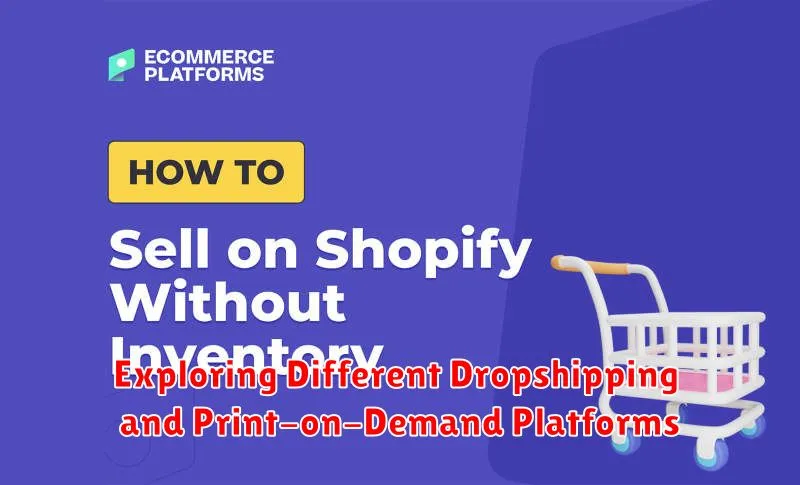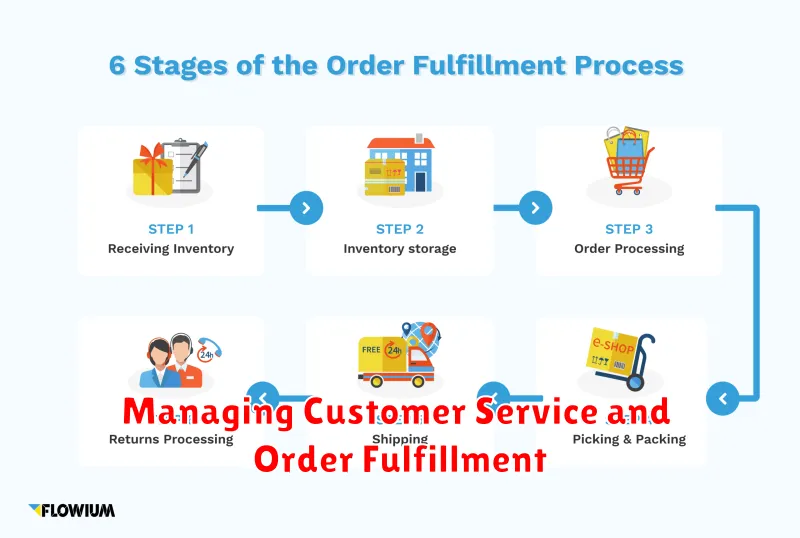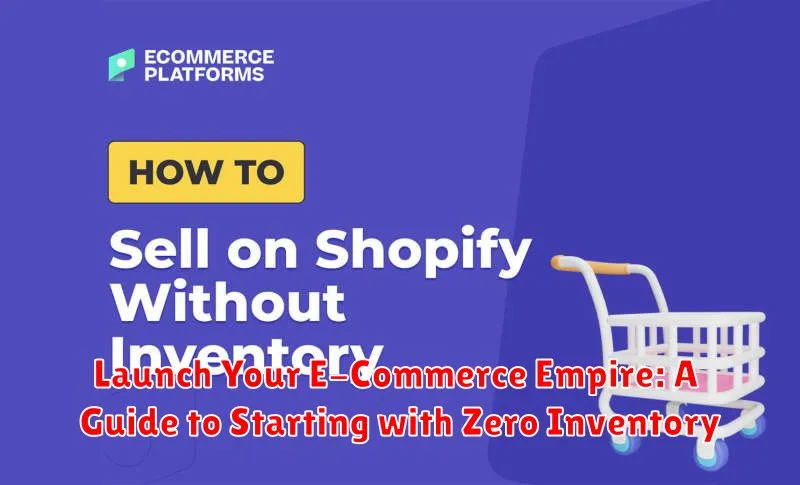Dreaming of launching your own e-commerce empire but overwhelmed by the thought of managing inventory? Starting an online business with zero inventory is entirely possible and increasingly popular. This comprehensive guide provides aspiring entrepreneurs with a practical roadmap to navigate the world of zero-inventory e-commerce, offering valuable insights into various business models, effective marketing strategies, and essential tools for success. Learn how to leverage dropshipping, print-on-demand, and other innovative approaches to minimize financial risk and maximize your potential for profit. Embark on your journey to building a thriving online business without the burden of traditional inventory management.
This guide will equip you with the knowledge and resources necessary to launch your e-commerce business from the ground up, even if you’re starting with absolutely zero inventory. Discover the core principles of e-commerce success, including market research, product selection, supplier partnerships, and effective customer service. We’ll delve into the advantages and disadvantages of different zero-inventory models, providing a clear understanding of which approach best aligns with your individual goals and resources. By the end of this guide, you’ll possess a concrete action plan to build your e-commerce empire without the complexities and costs associated with traditional inventory.
Understanding the Benefits of a No-Inventory Business Model
A no-inventory business model offers significant advantages for aspiring entrepreneurs. By eliminating the need to manage and store inventory, you can dramatically reduce startup costs and operational complexity. This approach allows you to focus on core business functions like marketing and customer service, rather than logistics.
Reduced Financial Risk is a key benefit. Without pre-purchased inventory, you avoid the risk of dead stock and minimize upfront investment. This allows for greater flexibility and adaptability to changing market trends. You only purchase products when a customer places an order, ensuring consistent cash flow.
Scalability is another advantage. Expanding your product offerings or increasing sales volume becomes significantly easier without the constraints of physical inventory. You can quickly adapt to customer demand and test new product lines without large financial commitments.
Location Independence is also enhanced with a no-inventory model. As you don’t need a warehouse or storage space, you can operate your business from virtually anywhere with an internet connection, providing greater flexibility and work-life balance.
Choosing the Right Products to Sell Without Inventory
Product selection is crucial for a successful zero-inventory e-commerce business. Choosing the right niche can make or break your venture.
Consider these factors when selecting products:
- Profitability: Look for products with healthy profit margins, accounting for supplier costs, platform fees, and marketing expenses.
- Demand: Research market trends and identify products with consistent demand. Utilize keyword research tools to gauge interest.
- Competition: Analyze the existing competition. A niche with low competition allows for easier market entry.
- Shipping Costs: Factor in shipping costs, especially with dropshipping. Lightweight, easily shipped items can minimize expenses.
- Supplier Reliability: Choose reliable suppliers who provide quality products and timely delivery for a positive customer experience.
Finding the right balance between these elements will help you build a profitable and sustainable business.
Exploring Different Dropshipping and Print-on-Demand Platforms

Embarking on a zero-inventory e-commerce venture requires careful selection of the right platform. Two prominent models are dropshipping and print-on-demand, each offering distinct advantages and disadvantages.
Dropshipping Platforms
Dropshipping involves partnering with suppliers who handle inventory and shipping directly to customers. Popular platforms like Spocket specialize in connecting businesses with US and EU suppliers for faster shipping times, while SaleHoo offers a vast directory of suppliers and comprehensive training resources. Worldwide Brands provides access to a curated selection of high-quality, name-brand products.
Print-on-Demand Platforms
Print-on-demand allows you to customize products with unique designs and sell them without managing inventory. Leading platforms include Printful, known for its wide product selection and user-friendly interface, and Printify, which connects businesses with a global network of print providers. Gooten offers another robust platform for print-on-demand fulfillment.
Selecting the right platform depends on your specific business goals and product niche. Carefully consider factors like product quality, shipping times, and platform fees to optimize your success.
Setting Up Your Online Store and Payment Gateway
Establishing your online presence begins with selecting the right e-commerce platform. Shopify, Wix, and Squarespace offer user-friendly interfaces and various pricing plans catering to different business needs. Consider factors like ease of use, scalability, and available integrations when making your choice.
Once you’ve chosen a platform, customize your store’s design to reflect your brand identity. A clean, professional look builds trust and encourages sales. Ensure your site is mobile-friendly, as a significant portion of online shopping happens on mobile devices.
Integrating a secure payment gateway is crucial for processing transactions. Popular options like Stripe and PayPal offer robust security and support multiple payment methods. Clearly display accepted payment options on your website to reassure customers.
Finally, thoroughly test your checkout process before launching. A smooth, error-free experience is essential for converting visitors into paying customers.
Creating a Marketing Strategy to Drive Traffic and Sales
A well-defined marketing strategy is crucial for attracting customers and generating sales. Visibility is key in the competitive e-commerce landscape. Consider these core components:
Target Audience
Identify your ideal customer. Understanding their demographics, interests, and online behavior will inform your marketing efforts. Where do they spend their time online? What are their pain points?
Content Marketing
Create valuable content that resonates with your target audience. This could include blog posts, articles, or social media updates related to your products. Focus on providing helpful information and building a community.
Social Media Marketing
Leverage social media platforms to connect with potential customers. Choose platforms relevant to your target audience and share engaging content. Run targeted ad campaigns to reach a wider audience and drive traffic to your store.
Search Engine Optimization (SEO)
Optimize your website and product listings for search engines. Use relevant keywords and ensure your site is easily navigable. This will improve your organic search rankings and drive more traffic from search engine results pages.
Paid Advertising
Consider using paid advertising platforms, such as Google Ads or social media ads, to reach a larger audience. Set a budget and track your results to ensure a positive return on investment.
Managing Customer Service and Order Fulfillment

Exceptional customer service is crucial for any business, especially in the competitive e-commerce landscape. With a zero-inventory model, managing customer service and order fulfillment requires a slightly different approach.
Communication is key. Keep customers informed throughout the process, from order confirmation to shipping updates. Proactively address potential delays or issues. A dedicated communication channel, whether email or a messaging platform, can streamline inquiries and build trust.
Order fulfillment relies heavily on your supplier relationships. Ensure they can handle order processing and shipping efficiently. Establish clear expectations regarding processing times and shipping costs. Consider offering various shipping options to cater to different customer needs.
Returns and refunds should be addressed clearly in your policy. Partnering with suppliers who handle returns efficiently simplifies the process for both you and the customer. A streamlined return process can significantly improve customer satisfaction.
Building a Strong Brand Identity and Customer Loyalty
In the competitive e-commerce landscape, a strong brand identity is crucial for attracting and retaining customers. It’s more than just a logo; it encompasses your values, messaging, and the overall experience you provide.
Define your target audience. Understanding their needs, preferences, and pain points will guide your branding efforts. Craft a unique value proposition that sets you apart from competitors. What makes your brand special? Why should customers choose you?
Develop a consistent brand voice and visual identity. This includes your logo, color palette, typography, and overall aesthetic. Consistency across all platforms builds recognition and trust.
Cultivate customer loyalty through exceptional service and personalized experiences. Engage with your customers on social media and respond promptly to inquiries. Consider loyalty programs or exclusive offers to reward repeat business.
Scaling Your No-Inventory Business for Growth
Once your no-inventory e-commerce business gains traction, strategic scaling is crucial for sustained success. This involves expanding your product offerings, reaching new markets, and optimizing your operations without significantly increasing overhead.
Expanding Product Selection: Diversify your product lines by partnering with new suppliers. Analyze sales data to identify trending products and customer preferences. Consider offering product bundles or personalized recommendations to increase average order value.
Marketing and Reach: Invest in targeted advertising campaigns to reach new customer segments. Explore influencer marketing and social media engagement to build brand awareness and drive traffic to your online store. Refine your SEO strategy to improve organic search visibility.
Automation and Optimization: Implement automation tools to streamline order processing, customer service, and inventory management. Analyze key performance indicators (KPIs) such as conversion rates, customer acquisition cost, and return rates to identify areas for improvement and optimize your business processes for efficiency.
Legal and Tax Considerations for E-Commerce Businesses
Navigating the legal and tax landscape is crucial for any e-commerce business, especially those operating with a zero-inventory model. Understanding the regulations and obligations can prevent future complications and ensure smooth business operations.
Business Structure: Choosing the right business structure (sole proprietorship, LLC, corporation) impacts liability, taxation, and administrative burden. Consult with a legal professional to determine the most suitable structure for your specific circumstances.
Sales Tax: Nexus is a key concept in sales tax. It determines where you have a physical presence or significant economic activity, requiring you to collect and remit sales tax. Rules vary by state, so research thoroughly or consult with a tax advisor.
Income Tax: Keep accurate records of all income and expenses. Dropshipping income is typically treated as regular business income, subject to federal and potentially state income tax.
Permits and Licenses: Depending on your location and business activities, you may require specific permits or licenses to operate legally. Check with your local and state government agencies for requirements.
Success Stories of No-Inventory E-Commerce Entrepreneurs
Examining real-world examples can provide valuable insights and motivation. Here are a few success stories of entrepreneurs who launched thriving e-commerce businesses with zero inventory:
Case Study 1: The Personalized Gift Curator
Sarah, a stay-at-home mom, recognized a demand for unique, personalized gifts. Partnering with various artisans, she created an online store offering customized items. She handled marketing and customer service, while the artisans produced and shipped the products directly to customers. This dropshipping model allowed her to build a profitable business without inventory management.
Case Study 2: The Niche Apparel Retailer
Mark, a graphic designer, identified a gap in the market for vintage-inspired band t-shirts. He utilized print-on-demand services to create and fulfill orders. His focus on a specific niche, combined with targeted marketing, led to a successful online store without holding any stock.
Case Study 3: The Tech Accessory Reseller
A college student, Maria, started reselling trending tech accessories through an online marketplace. She leveraged a wholesale agreement with a supplier who shipped products directly to her customers. This allowed her to gain experience in e-commerce and generate income without upfront inventory investment.

